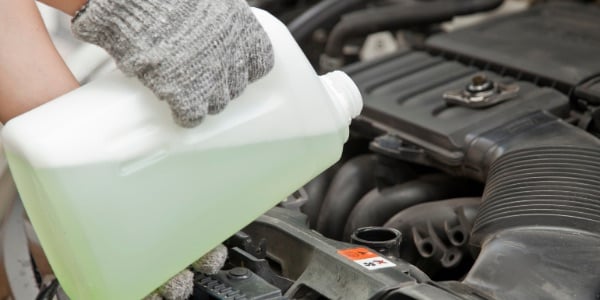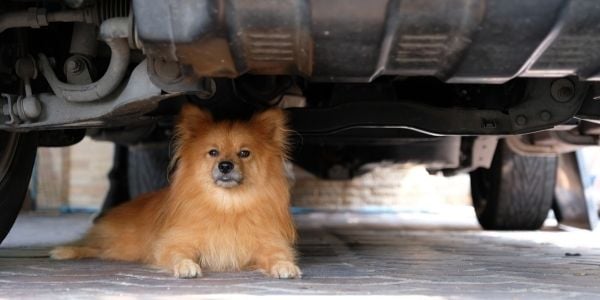
If your pet has consumed or you suspect they have had access to antifreeze, contact a veterinarian or Animal ER immediately. Antifreeze is fatal even if a very small amount is consumed.
If you’re like most people, you likely don’t think about the antifreeze in your car very often.
And you likely only change it or have it changed every few years.
But if you have pets (or children, or care about the environment), the brand of antifreeze you and your neighbors have in your cars and garages is very important. It is also vitally important that all cat and dog owners are aware of this very common pet danger.
Is Your Pet at Risk of Being Poisoned By Antifreeze?
- Do you change your car's fluids at home?
- Do you have a leaky car that drips on the pavement?
- Do your pets have access to your driveway or garage?
- Is your cat an outdoor cat that roams the neighborhood?
- Does your dog roam your neighborhood?
If you answered "yes" to any one of these questions, then please read on so you can learn about this common danger, what the signs of poisoning are and what to do to save your pet if they are exposed.
Ethylene Glycol – What Every Pet Owner Should Know
Most brands of antifreeze contain ethylene glycol, a chemical compound that is sweet-tasting and odorless. It causes significant, often fatal, problems for both cats and dogs. It can affect the nervous system and the kidneys.

Symptoms of Antifreeze Poisoning in Dogs and Cats
When an unsuspecting pet first licks up antifreeze — which, sadly, many do — the ethylene glycol (EG) can cause early signs, as soon as 30 minutes and up to a few hours after ingestion.
- depression
- lethargy
- staggering and loss of balance
- increased thirst and urination
- vomiting
- difficulty breathing
- excessive drooling due to the alcohol component of EG
- low body temperature
- seizures
- coma
You may have missed the initial symptoms, or your pet may seem like they are improving. But this does not mean your pet is safe. During this period of time (about 12 to 24 hours after ingestion), your pet is actually dehydrated, and there is an increase in their heart and respiratory rates.
 The more dangerous part of the toxicity though occurs when the liver starts to metabolize the EG into other compounds, which themselves have wide-ranging disastrous effects within the body.
The more dangerous part of the toxicity though occurs when the liver starts to metabolize the EG into other compounds, which themselves have wide-ranging disastrous effects within the body.
One of the most damaging effects is the formation of mineral crystals which settle in and lead to failure of the kidneys.
This is the main cause of death in ethylene glycol antifreeze poisoning cases, and this crystal formation can begin in as little as 12–24 hours for cats and 24–72 hours for dogs.
About 36 to 72 hours after ingestion has occurred, they get worse due to the fact that their kidneys are failing.
Signs that kidney failure is happening include:
- decreased energy and interactions
- depression
- lack of appetite
- vomiting
- increased thirst and urination (initially), followed by decreased thirst and lack of urination
- bad breath
- collapse
- seizures
- coma
- death
Treating Antifreeze Toxicity
Treatment is more likely to be effective when initiated prior to the formation of the mineral crystals that form 12–24 after a pet has eaten or licked antifreeze. Any pet that has known or suspected exposure to antifreeze should be brought immediately for veterinary evaluation and testing.
Dogs need to receive treatment within 5 to 8 hours, which hopefully is prior to kidney failure developing.
Cats, however, need to receive treatment within 3 hours of ingestion since they are more susceptible to the toxic effects.
Otherwise, the outcome for your dog or cat is poor.
Remember, it takes just a few licks to cause serious damage to a cat (licking it off their paws or their fur can be enough – they don't need to lick it directly off the ground or from a puddle), and just a few good laps can cause problems for a dog.
Further increasing the importance of early recognition and treatment in cases of exposure is the fact that the preferred treatment and antidote for ethylene glycol poisoning — a compound called Fomepizole (a.k.a. 4-MP or Antizol-Vet) — at the request of the manufacturer, FDA approval for this drug was pulled in April 2015. As of 12/21/2021, the FDA continues to list Antizol on the “Discontinued Drug Product List.” There is still another initial treatment for these cases, but that one (IV ethanol) has its own set of significant potential side effects and complications.
Story: We work with someone who accidentally poisoned his dog as a young man working on his car in his garage. He didn't realize the mess on the floor, made from the dripping antifreeze, was toxic to his dog. His dog licked a bit of it, and he unfortunately died. This is now many decades later, and this still haunts him. He wishes he would've known.
How to Prevent EG Antifreeze Toxicity in Pets
- Keep cats indoors and dogs under reliable leash control. Do not let your pets roam in places where antifreeze may be present such as driveways, streets, garages, etc.
- Be sure to close containers tightly and store antifreeze behind securely closed cabinet doors or on high shelves.
- Promptly and thoroughly clean up any antifreeze spills.
- Be sure to properly dispose of used antifreeze containers.
- Keep toilet seats down if you winterize your pipes.
- Regularly inspect your car’s radiator and repair all leaks immediately.
- Use or request a pet-safer propylene glycol (PG) based alternative (see list of brands below) whenever changing or topping off your engine coolant radiator fluid.
- Ask your car maintenance facility what they use to top up your engine and insist on a pet-safer option.
- Raise awareness amongst friends, neighbors, and family so they, too, can make pet-safer choices.
Use Pet-safer Antifreeze Brands
NOTE: While propylene glycol-based antifreeze is indeed pet-safer, it is by no means pet safe. Caution is still needed, but the risk associated with propylene glycol is less.
Here are some PG antifreeze brands that are safer for use around pets, stray cats, and wildlife:
- Star Brite Bio-Safe
- Star Brite Star-Cool
- Sierra by Peak
- Low-Tox by Prestone
- Amsoil

Where Else Is Ethylene Glycol Hiding?
It is important to be aware that ethylene glycol isn’t used just in car and truck antifreeze. It’s also present in these items, although not as in as high a concentration as antifreeze:
- Paints and industrial paint solvents
- Hydraulic brake fluids
- Brake fluid
- Windshield-washer fluids
- De-icers
- Fire extinguishers
- Adhesives
- Detergents
- Pesticides
- Polishes
- Printer cartridges
- Portable basketball hoop posts and bases
- Some cleaning products
- Some snow globes
- Some types of eye masks
- Some cleaning products
- Some ballpoint pens
- Some stamp pad inks
- Some cosmetics
- Some plastics
- Added to toilets in winter cabins in certain parts of the country (to prevent the water from freezing).
- In some places, it’s even added to garden fountains to prevent winter freezing. See how this last application is affecting cats in England.
As you can see from the long list, ethylene glycol poisoning isn’t just a winter worry. Therefore, try to always read the ingredients list and keep these and all other potential things locked safely away from your pets.
For areas where freezing conditions occur, check out our suggestions for pet safer ice melters and how to identify if your pet is suffering from being exposed to those that contain sodium chloride.
It cannot be said enough, that if you even slightly suspect your pet has been exposed to anything containing ethylene glycol, seek emergency care immediately. Your pet is at risk of dying without treatment.



